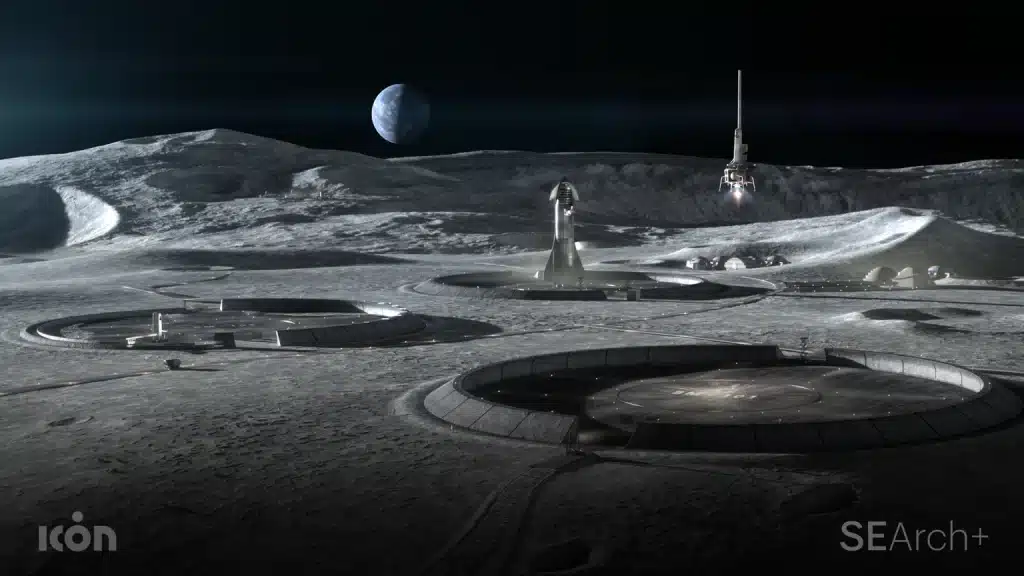Just over 50 years after its landmark Apollo missions ended, NASA is launching another series of moon explorations, named after the Greek god Apollo’s twin sister, Artemis.
The first Artemis mission, in which a rocket carrying no human passengers was launched to the moon, occurred in November 2022.
NASA is calling it a mission for “a new generation of explorers: the Artemis generation” and plans to take the first woman and person of color to the moon. They are keen to stress that this aim occurs in the context of “maintaining American leadership in exploration.”
As well as appealing to Gen Z, the overall goal of the Artemis mission is to find a human settlement on the moon, which can then be used as a basecamp for astronauts on their way to Mars. One of the main obstacles is getting building materials to the moon, as they are incredibly heavy and very expensive to transport by rocket—this is where ICON comes in.
ICON and 3D printing technology on earth
Texas-based tech company ICON has been building houses using 3D printing since technique since it was founded in 2017. They have already built social housing in Mexico and Texas, and in July this year, prospective buyers were taken for a tour around Wolf Ranch, the largest 3D-printed human settlement to date. This new neighborhood, part of a collaboration with collaboration homebuilding company Lennar and Danish architecture practice Bjarke Ingels Group (BIG), will contain 100 three and four-bedroom houses ranging from $475,000 to $599,000.
CBS reporter Lesley Stahl interviewed the founders this year about their collaboration with NASA and their projects. One of the founders, Jason Ballard, applied to be an astronaut but was rejected, and is extremely excited at the prospect of the first human settlements on the moon being built with ICON tech.

NASA’s gamble
NASA’s collaboration with ICON dates back to 2020 when they invested $30 million in ICON as part of their Moon to Mars Planetary Autonomous Construction Technologies (MMPACT) project. They were obviously pleased with ICON’s progress as they gave them an additional $57.2 million in 2022, presumably after the success of the first houses grew their confidence in the company.
But how will this technology work on the moon? The moon’s surface is covered with tiny particles of rock and minerals, known to us as ‘moon dust.’ This dust has caused problems for missions in the past, especially the huge clouds that are created when a rocket lands.
Four years ago, Raymond Clinton Jr., senior technical adviser of NASA’s science and technology office, worked out how this problem could be solved. The moon’s environment presents much harsher conditions than ours on Earth, with temperatures of up to 600 degrees as well as high levels of radiation. If manmade structures on the moon could be built out of a material that can withstand these conditions, they have a much better chance of surviving.
The basis for Icon’s building technology is a concrete mix called Lavacrete, piped out in liquid form by a robot to form layers that eventually amount to walls. Rather than bringing the concrete mix from Earth, ICON plans to use the moon dust already available to them to make building materials after landing.
What next?
Tests are already being done at the Marshall Space Flight Center to determine how moon dust could be converted into a building material using a synthetic replica created here on earth. If the method proves successful, the Artemis mission will attempt the capture the dust cloud created by their arrival, repurposing it for building. Dr Clinton says,
“The team will use what we learn from the tests with the lunar simulant to design, develop, and demonstrate prototype elements for a full-scale additive construction system.”
So there’s still quite a way to go before this technology is actually ready for use on the moon.
Jason Ballard remains hopeful that an ICON printer will land on the moon by the decade’s end. But he hasn’t lost sight of his projects here on earth either,
“I am confident that learning to build on other worlds will also provide the necessary breakthroughs to solve housing challenges we face in this world. These are mutually reinforcing endeavors. Sometimes, for the biggest problems, it becomes necessary to look up at the sky and not only down at our feet.”














